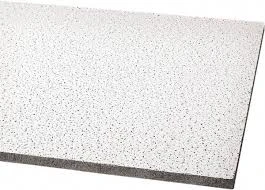Nov . 09, 2024 03:37 Back to list
Ceiling Tiles and Grids for Suspended Ceilings Installation and Design Solutions
Understanding Suspended Ceiling Grid and Tiles A Comprehensive Overview
Suspended ceiling systems, also known as drop ceilings or false ceilings, have become increasingly popular in both residential and commercial spaces. They serve not only as aesthetic enhancements to interior design but also provide functional benefits in terms of acoustics, insulation, and accessibility. This article delves into the concept of suspended ceiling grids and tiles, their components, installation process, advantages, and maintenance.
What is a Suspended Ceiling Grid?
A suspended ceiling grid refers to the network framework made of lightweight metal, often aluminum or steel, that is used to support ceiling tiles. This grid system is installed below the original ceiling structure, creating a hollow space in between. This vertical space allows the installation of various systems such as lighting, HVAC, and acoustic insulation, while also providing the ability to conceal wiring and plumbing.
The grid consists of main runners, cross tees, and wall angles, which work together to form a grid layout. The main runners run perpendicular to the ceiling's longest dimension and are spaced typically 4 feet apart. Cross tees are inserted between the main runners to create rectangular openings for the ceiling tiles, and wall angles are installed around the perimeter to give structural support.
Types of Ceiling Tiles
Once the grid is installed, a variety of ceiling tiles can be placed within it. Ceiling tiles come in different materials, finishes, sizes, and designs, allowing for tailored aesthetics and performance. Common materials include mineral fiber, fiberglass, tin, gypsum, and PVC. Each material offers distinct benefits, such as improved sound absorption, moisture resistance, or easy cleaning.
Mineral fiber tiles are one of the most popular options due to their affordability, sound insulation properties, and availability in various designs. Metal tiles, often used in commercial settings, can add a modern edge while being durable and easy to maintain. Slip-on tiles, which can be easily removed for access to the space above the ceiling, are particularly useful in areas requiring regular maintenance of hidden systems.
Installation Process
suspended ceiling grid and tiles

Installing a suspended ceiling requires careful planning and execution. It begins with measuring the room's dimensions to determine the grid layout. The grid is then marked on the walls, and the first main runner is anchored securely. Additional runners and cross tees are subsequently installed to create the full grid. Finally, the ceiling tiles are placed into the grid, ensuring they fit snugly into position.
This entire process benefits from the precision offered by the grid system, allowing for a level and uniform ceiling finish, which may not be achievable with traditional drywall ceilings
.Advantages of Suspended Ceilings
The advantages of suspended ceiling grids and tiles are manifold. First and foremost, they enhance the visual appeal of a space by offering a clean and sleek appearance. They can also contribute to excellent acoustic performance, making them ideal for offices, classrooms, and auditoriums where sound control is necessary.
Moreover, suspended ceilings improve energy efficiency by permitting better insulation, helping to reduce heating and cooling costs. Their design also facilitates easy access to utilities above the ceiling, which simplifies maintenance tasks. In the event of damage or aesthetic wear, individual tiles can be replaced without requiring extensive repairs.
Maintenance and Care
Maintaining suspended ceilings is relatively straightforward. Regular dusting and occasional cleaning with mild detergents will keep the tiles looking new. It's important to address any water stains quickly, which may indicate leaks or other issues that need attention.
In summary, suspended ceiling grids and tiles offer a versatile and practical solution for a wide range of spaces. Their ease of installation, aesthetic appeal, and functional benefits make them a popular choice among designers and builders. Whether for commercial or residential use, understanding the components and advantages of suspended ceiling systems can greatly enhance interior environments.
-
Quality Ceiling Trap Doors & Access Panels | Easy & Secure AccessNewsAug.30,2025
-
Durable Ceiling T Grid Systems | Easy InstallationNewsAug.29,2025
-
PVC Gypsum Ceiling: Durable, Laminated Tiles for Modern SpacesNewsAug.28,2025
-
Pvc Gypsum Ceiling Is DurableNewsAug.21,2025
-
Mineral Fiber Board Is DurableNewsAug.21,2025
-
Ceiling Tile Clip Reusable DesignNewsAug.21,2025







